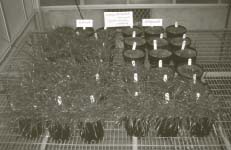|
Weed resistance to the
knockdown herbicides glyphosate, paraquat and diquat in cropping systems
Research Supervisors:
Dr David Bowran, Professor Jim Pratley, Dr
Chris Preston, Dr A. Hashem
Research Staff:
Mr John Broster
Funding:
$107,000 (GRDC)
Duration:
1997-2000

Roundup resistant ryegrass compared with
a susceptible sample.
Rates from the front are 0, ½, 1, & 2x.
Project Summary:
Herbicide resistance to Group A and Group B herbicides is now widespread in annual ryegrass,
and some cases of resistance to Group M
(glyphosate) are known. Cases of barley grass showing
resistance to Group A and Group L herbicides have
been reported. The development of widespread
resistance to the knockdown herbicides would pose
serious problems for Australian cropping systems given
our reliance on them for pre-seeding weed control
and seed set control in pastures. The monitoring of
grass weeds for resistance development to
knockdown herbicides is of significant importance if we intend
to be able to use these products as major tools
for integrated weed management over an extended period.
This project will test grass weeds collected
from across southern Australia in order to assess the
level of resistance to knockdown herbicides. Most
testing will be in the glasshouse but field testing on
paddock scale may be applicable. Rapid screens for
resistance testing will be evaluaed as alternatives to whole
plant tests. Models of the development of resistance will
be developed from the testing results, and strategies
to minimise the further development of resistance
to knockdowns developed within a cropping systems context.
A failure to find significant levels of resistance
to knockdown herbicides would have benefits in allowing the continued development of reduced
tillage systems, and in reducing the requirement for
in-crop herbicide and tillage inputs. The presence
of significant populations with potential for
resistance could encourage shifts to IWM strategies
which require less herbicide inputs, and possibly
the development of new cropping rotations. |

